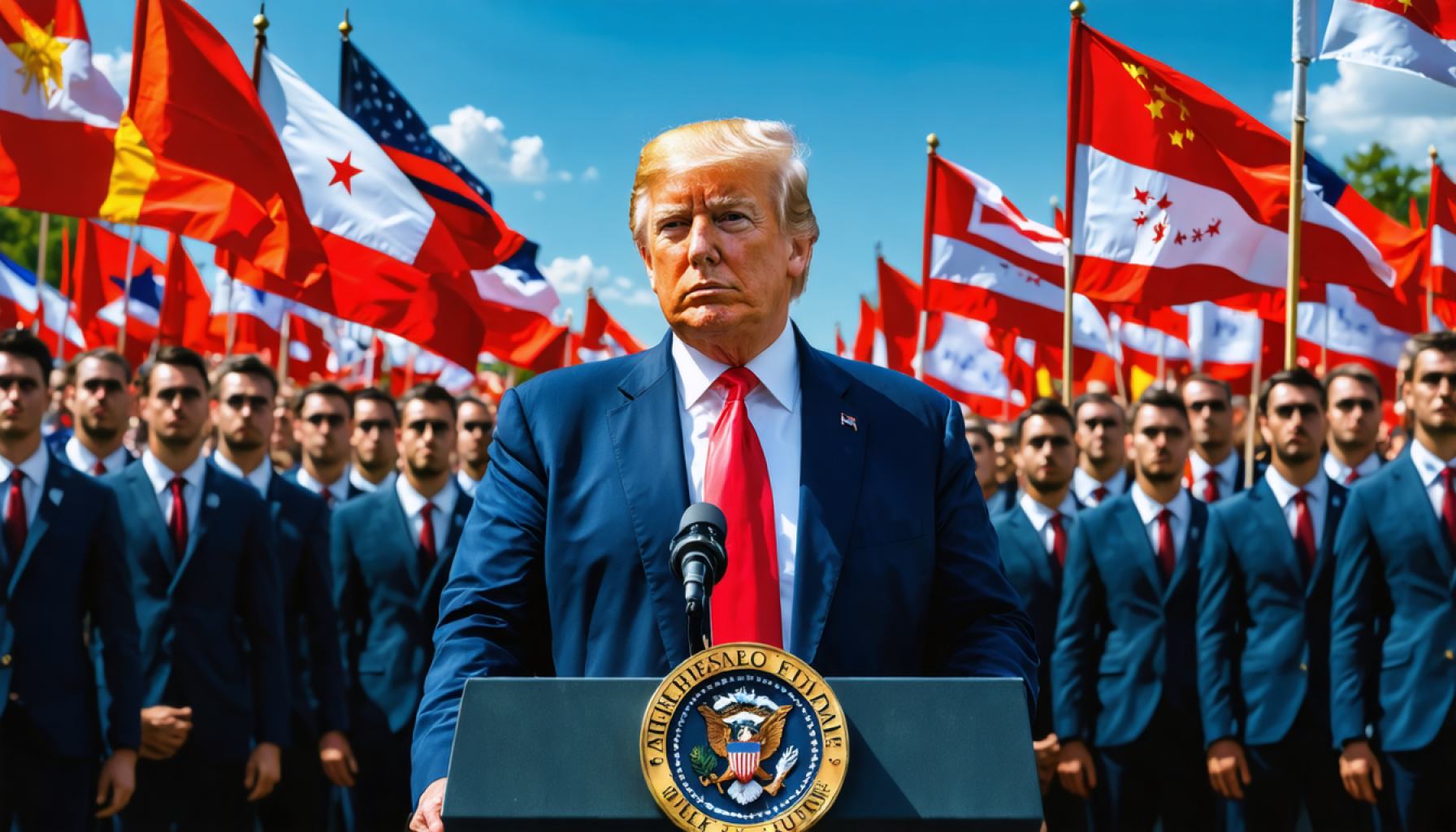- President Trump’s announcement of new tariffs signals a major shift in global trade policy, sparking economic speculation and concern.
- Dubbed “Liberation Day,” this change suggests a break from traditional trade systems, impacting global economic interactions.
- Wells Fargo predicts this shift could lead to deglobalization, creating distinct economic blocs led by the U.S., China, and a fragmented Europe.
- The new order may increase the complexity and cost of international business, affecting consumer prices and choices.
- Economic focus could shift inward, potentially benefiting domestic industries but hindering global growth and cooperation.
- Adaptability is crucial as businesses and governments must navigate and innovate amidst this evolving economic landscape.
- The ultimate impact of these changes will depend on the strategic decisions made by key economic players.
Amid the clamor of analysts and market pundits, President Trump’s unexpected announcement of new tariffs has set the global economic stage ablaze with speculation and concern. Like a sudden gust of wind disrupting a calm sea, these tariffs promise profound changes, shaking the foundations of international trade and heralding a significant transformation in how nations interact economically.
Referred to by some as “Liberation Day,” this pivot in U.S. trade policy might mark the beginning of an intriguing, albeit tumultuous, chapter in global economics. The metaphor of liberation is not to be taken lightly; it suggests an emancipation from traditional trading systems, a break from conventions that have long tied the hands of national policies to a global order orchestrated by economic interdependence. But with liberation comes uncertainty, and markets do not take well to uncertainty.
Wells Fargo, a prominent voice within the financial community, views this shift as a catalyst for deglobalization, an accelerating evolution toward economic fragmentation. They postulate that the world, once a sprawling tapestry of interconnected markets and economies, may unravel into distinct blocs dominated by titanic powers in a tri-polar arrangement: the U.S., China, and a fractured Europe. This newly proposed order implies a future where the cost of business cooperation rises and geopolitical alliances become more contentious.
The image conjured is one of fractured alliances and rising barriers, where goods and services flow less freely. Instead of seamless trade, businesses might face patchworks of regional agreements, each demanding navigation through complex tariffs. For consumers, this could mean higher prices and fewer choices. Countries now aligned economically could find themselves competing ruthlessly, where once they worked together.
While some might view the potential isolationism as beneficial – allowing nations to focus inward and bolster domestic industries – the broader implications could be a dimmed prospect for global economic growth and development. A triumphant economy does not flourish in isolation but thrives on exchange and cooperation.
Yet, within this unfolding narrative lies a key takeaway: adaptability. Businesses, governments, and investors must embrace agility, navigating the shifting sands of this new economic reality. As the global trading order reinvents itself, so too must the strategies that have guided companies and economies prosper and innovate.
In this era characterized by change and uncertainty, it becomes paramount to vigilantly observe and thoughtfully engage with these evolving principles of economics. Whether “Liberation Day” will be celebrated as a new dawn or lamented as a sunset on global unity will depend on the choices made by disruptors and facilitators alike.
The Unseen Impact of New Tariffs: Navigating the Global Trade Shift
The recent announcement of new tariffs by President Trump has ignited a wave of speculation among financial analysts and market experts. This policy shift, dubbed “Liberation Day” by some, suggests a potential re-ordering of international trade dynamics. Let’s delve deeper into the broader implications and potential outcomes of this significant economic move.
Key Facts and Insights
1. Deglobalization Trends: The introduction of tariffs is often seen as a step toward deglobalization. Wells Fargo predicts an emerging tri-polar world of the U.S., China, and a divided Europe. This could lead to an increase in regional trade blocs, making global trade more complicated and costly.
2. Economic Fragmentation: With rising domestic barriers, the flow of goods may become less seamless. Businesses will need to navigate variegated regional agreements, resulting in potentially higher operational costs and altered supply chains.
3. Consumer Impact: Consumers might face higher prices and decreased choices due to tariffs affecting international product availability.
4. Domestic Opportunities: There’s a potential upside for countries to bolster domestic industries. For example, U.S. manufacturing sectors that have struggled against international competition could gain ground under protective tariffs.
5. Adaptation and Agility: Companies and economies must focus on adaptability and innovation. Those able to pivot quickly can mitigate adverse impacts and capitalize on new opportunities in the changing landscape.
Questions and Answers
1. How will tariffs affect global economic growth?
Tariffs can slow global economic growth by increasing costs and reducing trade efficiency. A reduction in trade can lead countries to operate below optimal capacity, potentially stunting long-term growth prospects.
2. What industries are most likely to be affected?
Industries heavily reliant on international supply chains or exports, such as automotive, electronics, and agriculture, might be the most impacted. Companies in these sectors should evaluate supply chain resilience and consider diversifying sources.
Recommendations and Tips
– Stay Informed: Continually update your business strategies based on evolving trade policies and international relations.
– Build Resilience: Diversify supply chains to reduce dependency on any single market or supplier.
– Innovate Locally: Explore ways to strengthen and innovate within domestic markets to offset potential export losses.
– Monitor Consumer Trends: Pay attention to shifting consumer behaviors in response to price changes and adjust business strategies accordingly.
For further insights into global trade, consider visiting Wells Fargo for expert analysis and updates.
Conclusion
While the introduction of new tariffs represents a significant shift, it also presents opportunities for strategic growth and innovation. The path forward requires a balance of caution and proactive adaptation to flourish amid these changes. By staying agile and informed, businesses and investors can navigate these turbulent economic waters successfully.
